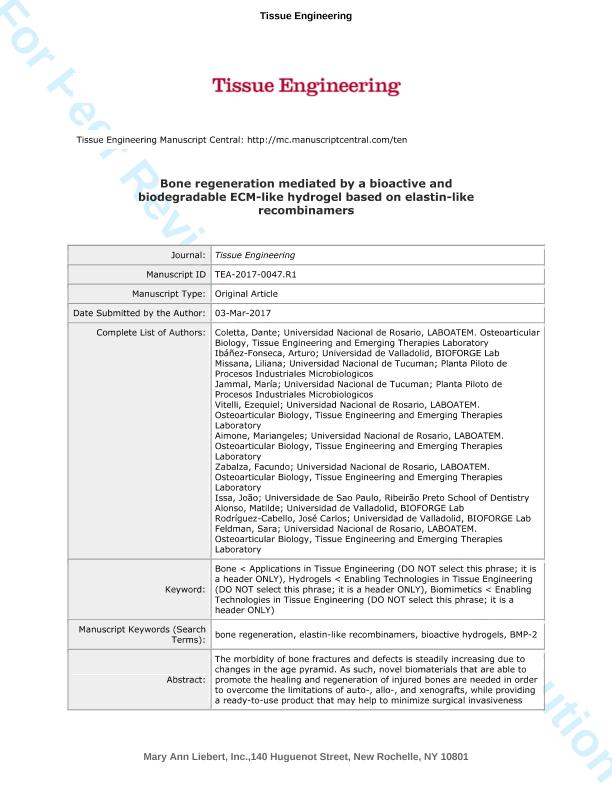Mostrar el registro sencillo del ítem
dc.contributor.author
Coletta, Dante Jesus

dc.contributor.author
Ibáñez Fonseca, Arturo
dc.contributor.author
Missana, Liliana Raquel

dc.contributor.author
Jammal, María Victoria

dc.contributor.author
Vitelli, Ezequiel J.
dc.contributor.author
Aimone, Mariangeles
dc.contributor.author
Zabalza, Facundo
dc.contributor.author
Issa, João P. Mardegan
dc.contributor.author
Alonso, Matilde
dc.contributor.author
Rodríguez Cabello, José Carlos
dc.contributor.author
Feldman, Sara

dc.date.available
2018-07-27T22:08:05Z
dc.date.issued
2017-12
dc.identifier.citation
Coletta, Dante Jesus; Ibáñez Fonseca, Arturo; Missana, Liliana Raquel; Jammal, María Victoria; Vitelli, Ezequiel J.; et al.; Bone regeneration mediated by a bioactive and biodegradable extracellular matrix-like hydrogel based on elastin-like recombinamers; Mary Ann Liebert; Tissue Engineering Part A; 23; 23-24; 12-2017; 1361-1371
dc.identifier.issn
1937-3341
dc.identifier.uri
http://hdl.handle.net/11336/53353
dc.description.abstract
The morbidity of bone fractures and defects is steadily increasing due to changes in the age pyramid. As such, novel biomaterials that are able to promote the healing and regeneration of injured bones are needed to overcome the limitations of auto-, allo-, and xenografts, while providing a ready-To-use product that may help to minimize surgical invasiveness and duration. In this regard, recombinant biomaterials, such as elastin-like recombinamers (ELRs), are very promising as their design can be tailored by genetic engineering, thus allowing scalable production and batch-To-batch consistency, among others. Furthermore, they can self-Assemble into physically crosslinked hydrogels above a certain transition temperature, in this case body temperature, but are injectable below this temperature, thereby markedly reducing surgical invasiveness. In this study, we have developed two bioactive hydrogel-forming ELRs, one including the osteogenic and osteoinductive bone morphogenetic protein-2 (BMP-2) and the other the Arg-Gly-Asp (RGD) cell adhesion motif. The combination of these two novel ELRs results in a BMP-2-loaded extracellular matrix-like hydrogel. Moreover, elastase-sensitive domains were included in both ELR molecules, thereby conferring biodegradation as a result of enzymatic cleavage and avoiding the need for scaffold removal after bone regeneration. Both ELRs and their combination showed excellent cytocompatibility, and the culture of cells on RGD-containing ELRs resulted in optimal cell adhesion. In addition, hydrogels based on a mixture of both ELRs were implanted in a pilot study involving a femoral bone injury model in New Zealand white rabbits, showing complete regeneration in six out of seven cases, with the other showing partial closure of the defect. Moreover, bone neoformation was confirmed using different techniques, such as radiography, computed tomography, and histology. This hydrogel system therefore displays significant potential in the regeneration of bone defects, promoting self-regeneration by the surrounding tissue with no involvement of stem cells or osteogenic factors other than BMP-2, which is released in a controlled manner by elastase-mediated cleavage from the ELR backbone.
dc.format
application/pdf
dc.language.iso
eng
dc.publisher
Mary Ann Liebert

dc.rights
info:eu-repo/semantics/openAccess
dc.rights.uri
https://creativecommons.org/licenses/by-nc-sa/2.5/ar/
dc.subject
Bioactive Hydrogels
dc.subject
Bmp-2
dc.subject
Bone Regeneration
dc.subject
Elastin-Like Recombinamers
dc.subject.classification
Salud Ocupacional

dc.subject.classification
Ciencias de la Salud

dc.subject.classification
CIENCIAS MÉDICAS Y DE LA SALUD

dc.title
Bone regeneration mediated by a bioactive and biodegradable extracellular matrix-like hydrogel based on elastin-like recombinamers
dc.type
info:eu-repo/semantics/article
dc.type
info:ar-repo/semantics/artículo
dc.type
info:eu-repo/semantics/publishedVersion
dc.date.updated
2018-06-26T22:33:54Z
dc.journal.volume
23
dc.journal.number
23-24
dc.journal.pagination
1361-1371
dc.journal.pais
Estados Unidos

dc.journal.ciudad
Nueva York
dc.description.fil
Fil: Coletta, Dante Jesus. Consejo Nacional de Investigaciones Científicas y Técnicas. Centro Científico Tecnológico Conicet - Rosario; Argentina. Universidad Nacional de Rosario. Facultad de Ciencias Médicas. Laboratorio de Biología Osteoarticular, Ingeniería Tisular y Terapias Emergentes; Argentina
dc.description.fil
Fil: Ibáñez Fonseca, Arturo. Universidad de Valladolid; España
dc.description.fil
Fil: Missana, Liliana Raquel. Consejo Nacional de Investigaciones Científicas y Técnicas. Centro Científico Tecnológico Conicet - Tucumán. Planta Piloto de Procesos Industriales Microbiológicos; Argentina. Universidad Nacional de Tucumán. Facultad de Odontología; Argentina
dc.description.fil
Fil: Jammal, María Victoria. Consejo Nacional de Investigaciones Científicas y Técnicas. Centro Científico Tecnológico Conicet - Tucumán. Planta Piloto de Procesos Industriales Microbiológicos; Argentina. Universidad Nacional de Tucumán. Facultad de Odontología; Argentina
dc.description.fil
Fil: Vitelli, Ezequiel J.. Universidad Nacional de Rosario. Facultad de Ciencias Médicas. Laboratorio de Biología Osteoarticular, Ingeniería Tisular y Terapias Emergentes; Argentina
dc.description.fil
Fil: Aimone, Mariangeles. Universidad Nacional de Rosario. Facultad de Ciencias Médicas. Laboratorio de Biología Osteoarticular, Ingeniería Tisular y Terapias Emergentes; Argentina
dc.description.fil
Fil: Zabalza, Facundo. Universidad Nacional de Rosario. Facultad de Ciencias Médicas. Laboratorio de Biología Osteoarticular, Ingeniería Tisular y Terapias Emergentes; Argentina
dc.description.fil
Fil: Issa, João P. Mardegan. Universidade de Sao Paulo; Brasil
dc.description.fil
Fil: Alonso, Matilde. Universidad de Valladolid; España
dc.description.fil
Fil: Rodríguez Cabello, José Carlos. Universidad de Valladolid; España
dc.description.fil
Fil: Feldman, Sara. Consejo Nacional de Investigaciones Científicas y Técnicas. Centro Científico Tecnológico Conicet - Rosario; Argentina. Universidad Nacional de Rosario. Facultad de Ciencias Médicas. Laboratorio de Biología Osteoarticular, Ingeniería Tisular y Terapias Emergentes; Argentina
dc.journal.title
Tissue Engineering Part A

dc.relation.alternativeid
info:eu-repo/semantics/altIdentifier/doi/https://dx.doi.org/10.1089/ten.TEA.2017.0047
dc.relation.alternativeid
info:eu-repo/semantics/altIdentifier/url/https://www.liebertpub.com/doi/10.1089/ten.tea.2017.0047
Archivos asociados
